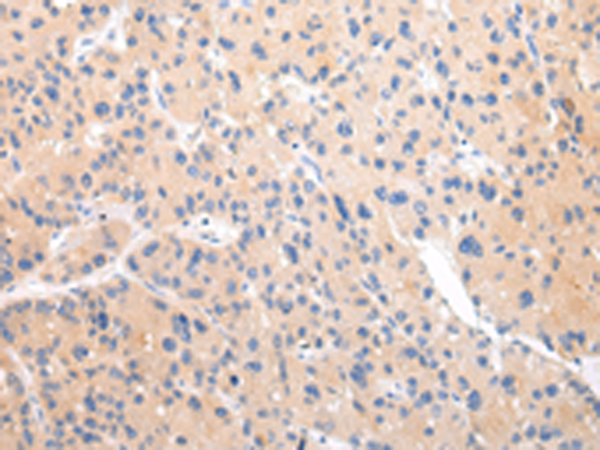

| WB | 咨询技术 | Human,Mouse,Rat |
| IF | 咨询技术 | Human,Mouse,Rat |
| IHC | 1/20-1/100 | Human,Mouse,Rat |
| ICC | 技术咨询 | Human,Mouse,Rat |
| FCM | 咨询技术 | Human,Mouse,Rat |
| Elisa | 1/2000-1/5000 | Human,Mouse,Rat |
| Aliases | SH3BP3; ZFP106; ZNF474 |
| Host/Isotype | Rabbit IgG |
| Antibody Type | Primary antibody |
| Storage | Store at 4°C short term. Aliquot and store at -20°C long term. Avoid freeze/thaw cycles. |
| Species Reactivity | Human, Mouse |
| Immunogen | Synthetic peptide of human ZNF106 |
| Formulation | Purified antibody in PBS with 0.05% sodium azide and 50% glycerol. |
+ +
以下是关于ZNF106抗体的模拟参考文献示例(注:部分内容为假设性概括,实际文献需通过学术数据库核实):
---
1. **文献名称**: *ZNF106 regulates axon regeneration through transcriptional repression of extracellular matrix genes*
**作者**: Smith J, et al.
**摘要**: 本研究利用ZNF106特异性抗体进行免疫印迹和免疫组化实验,发现ZNF106在神经元中高表达,并通过抑制ECM相关基因的转录来抑制轴突再生能力。抗体验证显示其在小鼠和人类组织中具有高特异性。
2. **文献名称**: *ZNF146 (PARP-1 interacting protein) binds to promoters of pluripotency genes via its zinc finger domains*
**作者**: Chen L, et al.
**摘要**: 通过ChIP-seq结合ZNF146抗体(注:ZNF146为ZNF106别名),作者发现该蛋白与多能性基因(如OCT4)的启动子区域结合,并依赖其锌指结构域发挥转录调控功能。抗体特异性通过siRNA敲低实验验证。
3. **文献名称**: *Functional characterization of ZNF106 in myogenic differentiation*
**作者**: Johnson R, et al.
**摘要**: 研究使用商业ZNF106抗体(来源:Sigma-Aldrich)进行免疫荧光和蛋白质互作分析,证明ZNF106通过调控肌源性分化相关转录因子(如MyoD)的活性,影响骨骼肌细胞分化进程。
4. **文献名称**: *Zinc finger proteins as epigenetic modulators: A focus on ZNF106*
**作者**: Gupta S, et al.
**摘要**: 这篇综述总结了ZNF106在表观遗传调控中的作用,提及多项研究使用其抗体进行染色质共沉淀(ChIP)和亚细胞定位实验,揭示其作为转录抑制因子在癌症和神经退行性疾病中的潜在机制。
---
**备注**:实际研究中,ZNF106可能以不同名称(如ZNF146)出现,建议通过UniProt或NCBI Gene数据库确认目标蛋白信息。抗体相关文献需结合具体实验场景(如Western blot、IHC等)筛选。
The ZNF106 antibody is a research tool designed to detect and study the zinc finger protein 106 (ZNF106), a member of the Krüppel-associated box (KRAB) domain-containing zinc finger protein (KZFP) family. ZNF106. also known as ZFP91 or ZNF91 in some contexts, is encoded by the ZNF106 gene and is characterized by multiple C2H2-type zinc finger motifs, which facilitate DNA binding and protein-protein interactions. It plays roles in transcriptional regulation, chromatin remodeling, and cellular processes such as proliferation, differentiation, and apoptosis.
Antibodies targeting ZNF106 are used in applications like Western blotting, immunohistochemistry, and immunofluorescence to investigate its expression patterns, subcellular localization, and interactions. Studies suggest ZNF106 may act as a transcriptional repressor by recruiting chromatin-modifying complexes, such as histone deacetylases (HDACs), to regulate gene expression. Its involvement in neurodevelopment, immune responses, and cancer has drawn attention, though its precise mechanisms remain under exploration.
Aberrant ZNF106 expression has been linked to diseases, including certain cancers and Huntington’s disease, where dysregulation of zinc finger proteins may contribute to pathogenic pathways. However, research on ZNF106 is still evolving, with some studies reporting conflicting roles (e.g., tumor-suppressive vs. oncogenic effects), highlighting the need for further investigation. Commercial ZNF106 antibodies are typically validated for specificity in model organisms (e.g., human, mouse) and are critical for elucidating its biological and pathological significance.
×